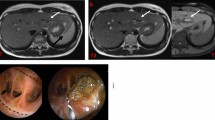Abstract
Congenital biliary dilatation (CBD) is usually associated with complications such as recurrent cholangitis, manifested as abdominal pain, vomiting, and jaundice. If cholangitis cannot be controlled by conservative treatment, a good therapeutic effect can be obtained through percutaneous biliary drainage or open T-tube drainage. We aimed to evaluate our experiences in biliary drainage through endoscopic retrograde cholangiopancreatography in children with cholangitis caused by CBD. From January 2014 to December 2017, 167 children with CBD were treated in our hospital. 17 patients (10.18%) with serious cholangitis caused by CBD underwent ERCP. There were 4 males and 13 females with an age range of 10–120 months (average 56.4 months). Placement of a biliary stent was attempted for biliary drainage through endoscopic retrograde cholangiopancreatography. Of the 17 patients studied, 13 children had jaundice and 15 had elevated aminotransferases. ERCP showed CBD in all patients and a common biliopancreatic duct in 12 of 17 patients (70.6%). Five patients underwent nasobiliary drainage and 12 patients underwent biliary drainage through double pigtail tubes. All patients achieved successful biliary drainage. Postoperative pancreatitis occurred in one patient. Biochemical indicators decreased significantly in 12 patients (70.6%) on the second postoperative day. The average length of hospital stay after surgery was 4.5 (range 3–7) days. No major complications related to ERCP were observed and all children had a good prognosis so far. Endoscopic biliary drainage is a safe, simple, and reliable technique. It can be used to resolve CBD-associated cholangitis, evaluate the biliary tract and pancreatobiliary duct junction, and guide pediatric surgeons to choose the right time and the correct procedure for CBD.


Similar content being viewed by others
References
O’Neill JA (1992) Choledochal cyst. Curr Probl Surg 29:361–410
Urushihara N, Hamada Y, Kamisawa T, Fujii H, Koshinaga T, Morotomi Y, Saito T, Itoi T, Kaneko K, Fukuzawa H, Ando H (2017) Classification of pancreaticobiliary maljunction and clinical features in children. J Hepatobiliary Pancreat Sci 8:449–455
Babbitt DP (1969) Congenital choledochal cysts: new etiological concepts on anomalous relationships of the common bile duct and pancreatic bulb. Ann Radiol (Paris) 12(3):231–240
Terui K, Yoshida H, Kouchi K, Hishiki T, Saito T, Mitsunaga T, Takenouchi A, Tsuyuguchi T, Yamaguchi T, Ohnuma N (2008) Endoscopic sphincterotomy is a useful preoperative management for refractory pancreatitis associated with pancreaticobiliary maljunction. J Pediatr Surg 43:495–499
Troendle DM, Barth BA (2013) ERCP can be safely and effectively performed by a pediatric gastroenterologist for choledocholithiasis in a pediatric facility. J Pediatr Gastroenterol Nutr 57:655–658
Saito T, Terui K, Mitsunaga T, Nakata M, Kuriyama Y, Higashimoto Y, Kouchi K, Onuma N, Takahashi H, Yoshida H (2014) Role of pediatric endoscopic retrograde cholangiopancreatography in an era stressing less-invasive imaging modalities. J Pediatr Gastroenterol Nutr 59(2):204–209
Todani T, Watanabe Y, Narusue M, Tabuchi K, Okajima K (1977) Congenital bile duct cysts: classification, operative procedures, and review of thirty-seven cases including cancer arising from choledochal cyst. Am J Surg 134(2):263–269
Lal R, Agarwal S, Shivhare R, Kumar A, Sikora SS, Kapoor VK, Saxena R (2007) Management of complicated choledochal cysts. Dig Surg 24:456–462
Kahriman G, Ozcan N, Gorkem SB (2018) Percutaneous management of benign biliary disorders in children. Diagn Interv Imaging 99:37–42
Jang JY, Yoon CH, Kim KM (2010) Endoscopic retrograde cholangiopancreatography in pancreatic and biliary tract disease in Korean children. World J Gastroenterol 16(4):490–495
Paris C, Bejjani J, Beaunoyer M, Ouimet A (2010) Endoscopic retrograde cholangiopancreatography is useful and safe in children. J Pediatr Surg 45:938–942
Drabek J, Keil R, Stovicek J, Lochmannova J, Hlava S, Snajdauf J, Rygl M, Nevoral J (2017) The role of endoscopic retrograde cholangiopancreatography in choledochal cysts and/or abnormal pancreatobiliary junction in children. Prz Gastroenterol 12(4):303–309
Limketkai BN, Chandrasekhara V, Kalloo AN, Okolo PI (2013) Comparison of performance and safety of endoscopic retrograde cholangiopancreatography across pediatric age groups. Dig Dis Sci 58:2653–2660
Tsuchiya H, Kaneko K, Itoh A, Kawashima H, Ono Y, Tainaka T, Murase N, Ando H (2013) Endoscopic biliary drainage for children with persistent or exacerbated symptoms of choledochal cysts. J Hepatobiliary Pancreat Sci 20(3):303–306
De Angelis P, Foschia F, Romeo E, Caldaro T, Rea F, di Abriola GF, Caccamo R, Santi MR, Torroni F, Monti L, Dall’Oglio L (2012) Role of endoscopic retrograde cholangiopancreatography in diagnosis and management of congenital choledochal cysts: 28 pediatric cases. J Pediatr Surg 47:885–888
Minagawa T, Dowaki S, Kikunaga H, Fujita K, Ishikawa K, Mori K, Sakuragawa T, Ichisaka S, Miura H, Kumai K, Mikami S, Kitagawa Y (2015) Endoscopic biliary drainage as a bridging procedure to single-stage surgery for perforated choledochal cyst: a case report and review of the literature. Surg Case Rep 1:1–6
Poddar U, Thapa BR, Bhasin DK, Prasad A, Nagi B, Singh K (2001) Endoscopic retrograde cholangiopancreatography in the management of pancreaticobiliary disorders in children. J Gastroenterol Hepatol 16:927–931
Funding
None.
Author information
Authors and Affiliations
Contributions
JC and DY wrote the main body of the article under the supervision of BS. HW provided advice on medical aspects. All authors contributed to the design and interpretation of the study and further drafts. Bin Sun is the guarantor.
Corresponding author
Ethics declarations
Conflict of interest
All the authors (Bin Sun, DongHai Yu, Ji Chen, YongHui Tang, Han Wu) declare that they have no conflict of interest.
Ethical approval
All procedures performed in studies involving human participants were in accordance with the ethical standards of the institutional and/or national research committee and with the 1964 Helsinki declaration and its later amendments or comparable ethical standards.
Informed consent
Informed consent was obtained from all individual participants included in the study.
Rights and permissions
About this article
Cite this article
Sun, B., Yu, D., Chen, J. et al. Endoscopic biliary drainage management for children with serious cholangitis caused by congenital biliary dilatation. Pediatr Surg Int 34, 897–901 (2018). https://doi.org/10.1007/s00383-018-4296-3
Accepted:
Published:
Issue Date:
DOI: https://doi.org/10.1007/s00383-018-4296-3




